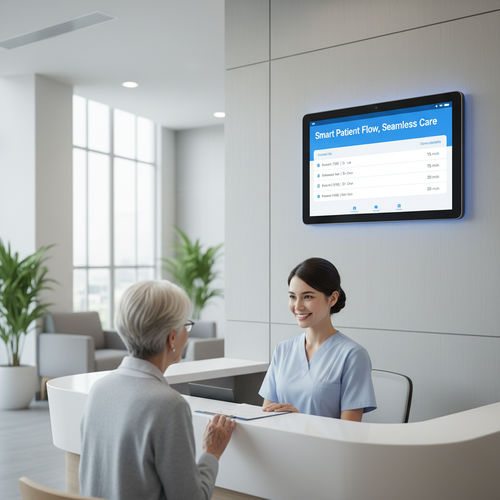When Patient Flow Becomes a Bottleneck
In busy hospitals, efficiency is more than a KPI—it directly shapes patient experience. As daily patient volume grows, manual scheduling systems quickly become outdated. Doctors rotate between rooms, appointments shift constantly, and staff must manually communicate changes. Without real-time visibility, diagnosis rooms become bottlenecks, leading to delays and frustration.
A Modern Hospital’s Scheduling Struggle
A major hospital in Southeast Asia faced this exact challenge. With over 40 outpatient diagnosis rooms operating daily, they relied heavily on printed schedules and nurse updates. When shifts changed or delays occurred, there was no fast way to notify patients or staff. Patients queued outside the wrong rooms, and medical teams spent time redirecting them instead of focusing on clinical work.
The hospital’s leadership realized they needed a digital solution to display real-time room status, doctor availability, and patient queues—right outside each room.

The Hidden Cost of Manual Coordination
Before digitalization, a nurse coordinator updated paper signs multiple times a day. This consumed hours of administrative work and resulted in frequent miscommunication. Room downtime became common—one doctor finished early while another room remained congested. The hospital calculated over 20 minutes of wasted time per doctor per shift due to inefficient coordination.
These inefficiencies didn’t just slow operations—they reduced patient satisfaction and overall throughput.

Turning to Digital Diagnosis Room Displays
The hospital decided to adopt a modern digital diagnosis room display solution built around commercial-grade Android-based tablets. Instead of relying on consumer devices, they selected medical room display tablets specifically engineered for healthcare environments.
Each display tablet was mounted outside consultation rooms, showing real-time doctor schedules, patient queues, and room availability.
Unlike consumer electronics, the commercial models used in this project offered:
-
24/7 continuous operation
-
Anti-bacterial touch surfaces
-
Secure network integration
-
Stability suited for clinical workflows
Every tablet acted as a dynamic digital door sign connected to the hospital’s core HIS (Hospital Information System).

How the Tablets Integrated with the HIS System
The IT team integrated the tablets using a custom API, allowing data to sync directly from the HIS. Doctor names, specialties, appointment times, and queue numbers updated in real time.
The interface supported multi-language display and used color-coded indicators—green for available, red for occupied—to make room status instantly clear.
For staff, the system removed the need for phone calls and clipboards.
For patients, navigation became intuitive and stress-free.

From Chaos to Clarity in Daily Operations
Within one month, the hospital installed more than 60 Smart Diagnosis Room Tablets across departments.
The impact was immediate:
-
Front desk staff could monitor room occupancy from a central dashboard
-
Doctors benefited from automatic schedule synchronization
-
Patients found the correct rooms quickly using the digital clinic door signs
The tablets also displayed custom messages like “Doctor on Break" or “Next Appointment in Progress," helping set expectations and improving flow.

Results That Speak: Faster Turnover, Happier Patients
After three months, the improvements were significant:
-
27% increase in room utilization
-
40% reduction in patient misrouting
-
Smoother appointment turnover
-
More time for nurses to focus on clinical duties
Patients praised the clarity and convenience of the digital displays, calling the system “simple and stress-free."
One administrator noted:
“Before, everything depended on paper and phone calls. Now, updates are automatic and precise."
Redefining Efficiency in Modern Healthcare
The success of this project motivated other hospital branches to adopt similar systems. It proved that digital room displays are not just operational tools—they are essential for modern healthcare efficiency.
By combining enterprise-grade Android tablets, real-time synchronization, and tailored UI design, hospitals can significantly optimize scheduling, reduce operational friction, and enhance patient experience.
As healthcare continues evolving, smart room displays will become standard tools for:
-
Clinic scheduling
-
Patient flow management
-
Digital hospital signage
This deployment stands as a clear example of how intelligent tablet-based systems can transform medical operations from chaotic to coordinated

 ข้อความของคุณจะต้องอยู่ระหว่าง 20-3,000 ตัวอักษร!
ข้อความของคุณจะต้องอยู่ระหว่าง 20-3,000 ตัวอักษร! กรุณาตรวจสอบอีเมลของคุณ!
กรุณาตรวจสอบอีเมลของคุณ!  ข้อความของคุณจะต้องอยู่ระหว่าง 20-3,000 ตัวอักษร!
ข้อความของคุณจะต้องอยู่ระหว่าง 20-3,000 ตัวอักษร! กรุณาตรวจสอบอีเมลของคุณ!
กรุณาตรวจสอบอีเมลของคุณ! 
